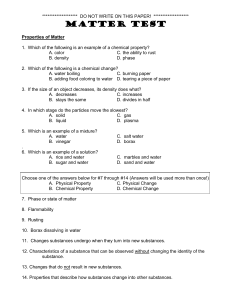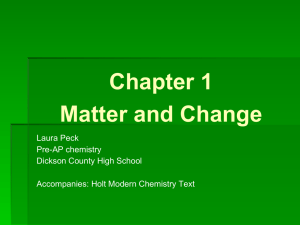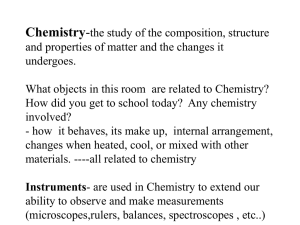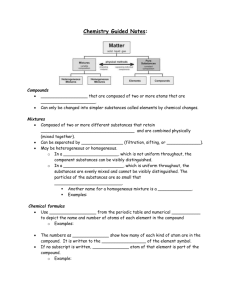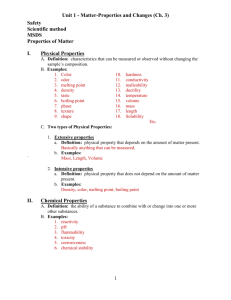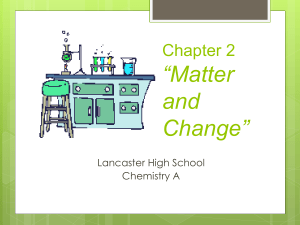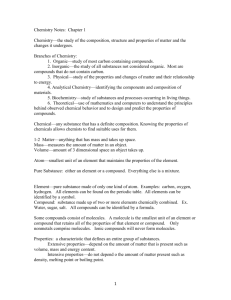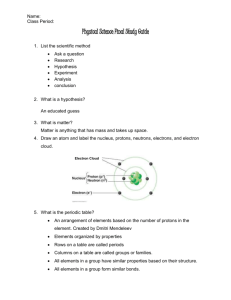Holt Modern Chemistry -
advertisement
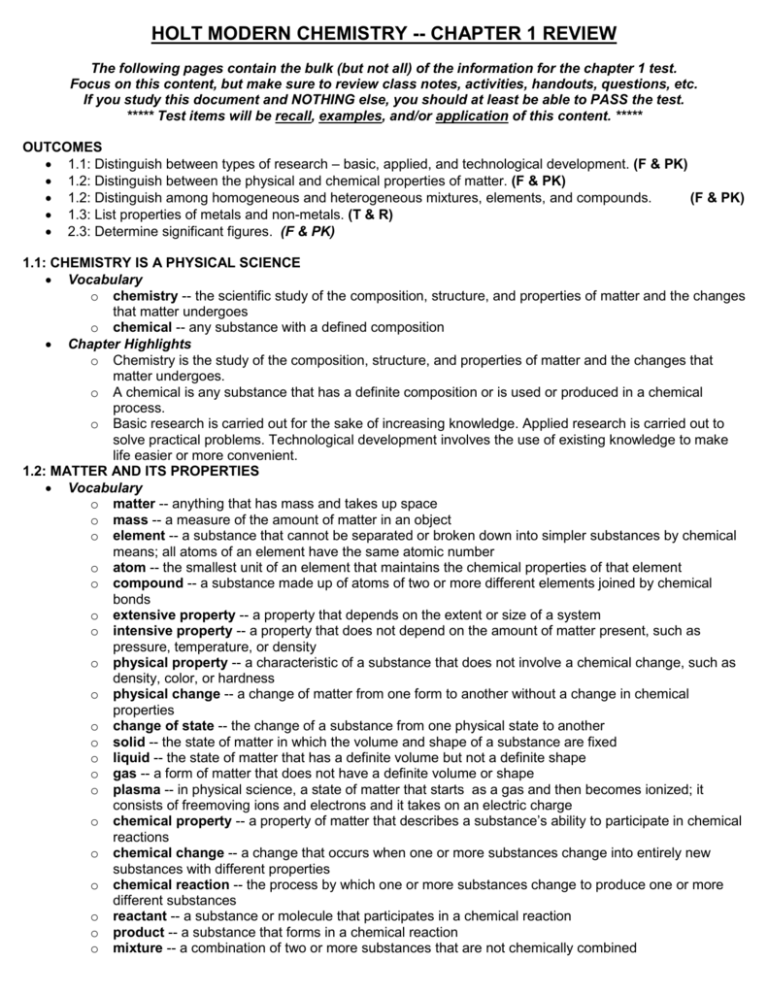
HOLT MODERN CHEMISTRY -- CHAPTER 1 REVIEW The following pages contain the bulk (but not all) of the information for the chapter 1 test. Focus on this content, but make sure to review class notes, activities, handouts, questions, etc. If you study this document and NOTHING else, you should at least be able to PASS the test. ***** Test items will be recall, examples, and/or application of this content. ***** OUTCOMES 1.1: Distinguish between types of research – basic, applied, and technological development. (F & PK) 1.2: Distinguish between the physical and chemical properties of matter. (F & PK) 1.2: Distinguish among homogeneous and heterogeneous mixtures, elements, and compounds. (F & PK) 1.3: List properties of metals and non-metals. (T & R) 2.3: Determine significant figures. (F & PK) 1.1: CHEMISTRY IS A PHYSICAL SCIENCE Vocabulary o chemistry -- the scientific study of the composition, structure, and properties of matter and the changes that matter undergoes o chemical -- any substance with a defined composition Chapter Highlights o Chemistry is the study of the composition, structure, and properties of matter and the changes that matter undergoes. o A chemical is any substance that has a definite composition or is used or produced in a chemical process. o Basic research is carried out for the sake of increasing knowledge. Applied research is carried out to solve practical problems. Technological development involves the use of existing knowledge to make life easier or more convenient. 1.2: MATTER AND ITS PROPERTIES Vocabulary o matter -- anything that has mass and takes up space o mass -- a measure of the amount of matter in an object o element -- a substance that cannot be separated or broken down into simpler substances by chemical means; all atoms of an element have the same atomic number o atom -- the smallest unit of an element that maintains the chemical properties of that element o compound -- a substance made up of atoms of two or more different elements joined by chemical bonds o extensive property -- a property that depends on the extent or size of a system o intensive property -- a property that does not depend on the amount of matter present, such as pressure, temperature, or density o physical property -- a characteristic of a substance that does not involve a chemical change, such as density, color, or hardness o physical change -- a change of matter from one form to another without a change in chemical properties o change of state -- the change of a substance from one physical state to another o solid -- the state of matter in which the volume and shape of a substance are fixed o liquid -- the state of matter that has a definite volume but not a definite shape o gas -- a form of matter that does not have a definite volume or shape o plasma -- in physical science, a state of matter that starts as a gas and then becomes ionized; it consists of freemoving ions and electrons and it takes on an electric charge o chemical property -- a property of matter that describes a substance’s ability to participate in chemical reactions o chemical change -- a change that occurs when one or more substances change into entirely new substances with different properties o chemical reaction -- the process by which one or more substances change to produce one or more different substances o reactant -- a substance or molecule that participates in a chemical reaction o product -- a substance that forms in a chemical reaction o mixture -- a combination of two or more substances that are not chemically combined o o homogeneous -- describes something that has a uniform structure or composition throughout solution -- a homogeneous mixture of two or more substances uniformly dispersed throughout a single phase o heterogeneous -- composed of dissimilar components o pure substance -- a sample of matter, either a single element or a single compound, that has definite chemical and physical properties Chapter Highlights o All matter has mass and takes up space. Mass is one measure of the amount of matter. o Chemical properties refer to a substance’s ability to undergo changes that alter its composition and identity. o An element is composed of one kind of atom. Compounds are made from two or more elements in fixed proportions. o All substances have characteristic properties that enable chemists to tell the substances apart and to separate the substances. o Physical changes do not involve changes in identity of a substance. o The three major states of matter are solid, liquid, and gas. Changes of state, such as melting and boiling, are physical changes. o In a chemical change—or a chemical reaction—the identity of the substance changes. o Energy changes accompany physical and chemical changes. Energy may be released or absorbed, but it is neither created nor destroyed. o Matter can be classified into mixtures and pure substances. 1.3: ELEMENTS Vocabulary o group -- a vertical column of elements in the periodic table; elements in a group share chemical properties o family -- a vertical column of the periodic table o period -- in chemistry, a horizontal row of elements in the periodic table o metal -- an element that is shiny and that conducts heat and electricity well o nonmetal -- an element that conducts heat and electricity poorly and that does not form positive ions in an electrolytic solution o metalloid -- an element that has properties of both metals and nonmetals; sometimes referred to as a semiconductor Chapter Highlights o Each element has a unique symbol. The periodic table shows the elements organized by their chemical properties. Columns on the table represent groups or families of elements that have similar chemical properties. Properties vary across the rows, or periods. o The elements can be classified as metals, nonmetals, metalloids, and noble gases. These classes occupy different areas of the periodic table. Metals tend to be shiny, malleable, and ductile and tend to be good conductors. Nonmetals tend to be brittle and tend to be poor conductors. o Metalloids are intermediate in properties between metals and nonmetals, and they tend to be semiconductors of electricity. The noble gases are generally unreactive elements. 2.3: USING SCIENTIFIC MEASUREMENTS Vocabulary o significant figure -- a prescribed decimal place that determines the amount of rounding off to be done based on the precision of the measurement Chapter Highlights o The significant figures in a number consist of all digits known with certainty plus one final digit, which is uncertain. o After multiplication or division, the answer should be rounded so that it has no more significant figures than there are in the measurement that has the fewest number of significant figures. Significant Figures RULES o Every nonzero digit is significant. o Zeros between nonzero digits are significant. o If there is no decimal point, zeros that follow the last nonzero digit are not significant. o Zeros appearing in front of the first nonzero digit are not significant. o If there is a decimal point, zeros that follow the last nonzero digit are significant. o When measurements are multiplied or divided, the result must be rounded to the same number of significant figures that the measurement with the smallest number of significant figures has.
